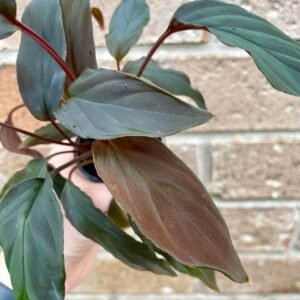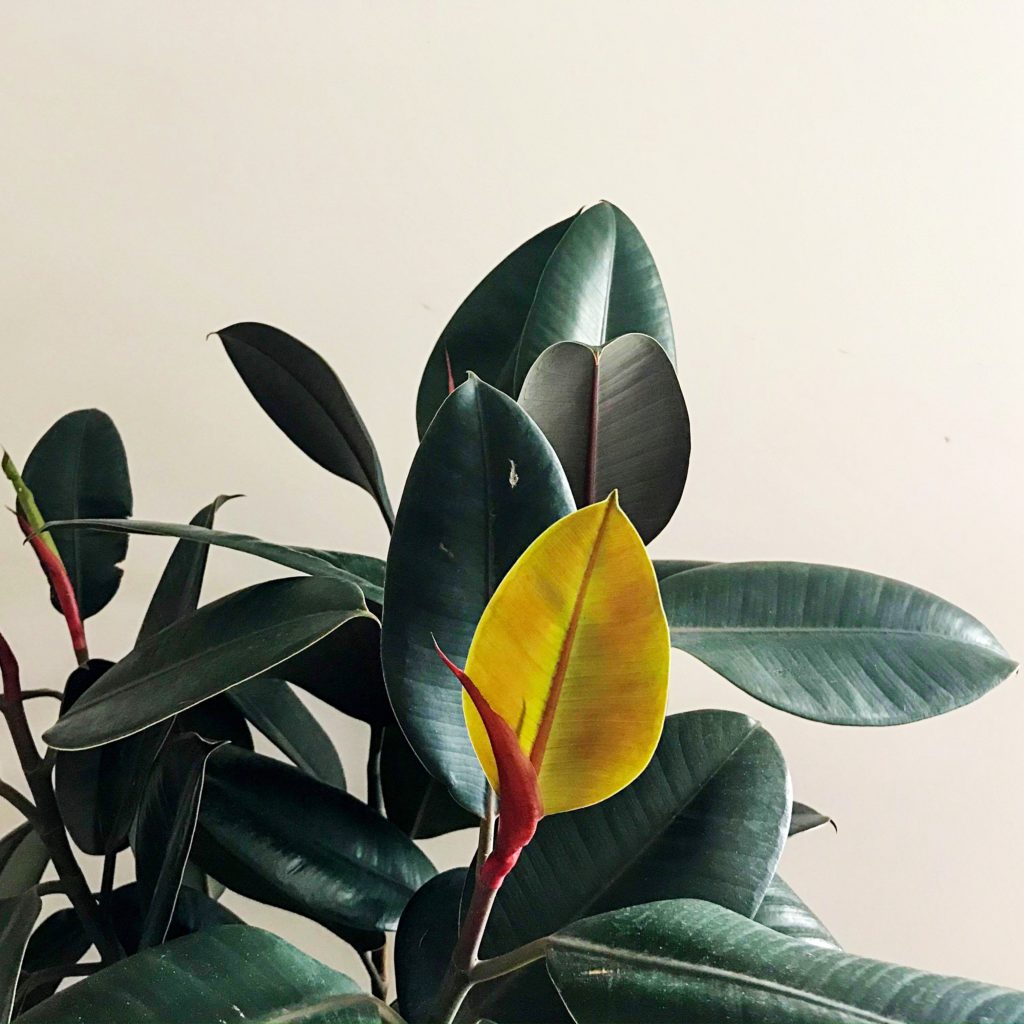Homalomena Humilis a.k.a Homalomena Black Satin, Homalomena Humilis Black, Homalomena Jungle Satin
The Homalomena Jungle Satin is a gorgeous plant to add to your collection. The foliage is velvety to touch and the new growth starts off a burgundy colour before going to a darker brownish colour as the leaf hardens. The underside of the foliage is a red colour. Homalomena Jungle Satin is part of the Araceae family and originates from Indonesia. Unfortunately, this plant is toxic if ingested and should be kept away from children and pets.

Homalomena Jungle Satin Quick Overview
| Full Size | Up to 31 inches |
| Light | Medium – bright indirect light |
| Temperature | 59ºF-80ºF (15ºC-26ºC) |
| Humidity | 50%-70% |
| Cost | $ |
| Care Level | Easy |
| Toxicity | Toxic |
Size
The size of a Homalomena Jungle Satin can be between 11- 27 inches in height and 19-31 inches in width. This plant is a clumping plant which means is grows its leaves outwards from the centre of the plant and maintains a compact shape. The Homalomena Jungle Satin is also known to be a slow grower.
Homalomena Jungle Satin Light Requirements
Homalomena Jungle Satin will grow best when in medium to bright indirect lighting. However, this plant will also tolerate low light conditions. It’s best to try and avoid direct sunlight as the harsh rays will burn the foliage. The foliage of your Homalomena Jungle Satin can begin to fade and get burnt spots as a sign of too much direct sunlight. The plant may have slow or stunted growth as a result of lower light. Moving your plant to a spot where it receives brighter light will help keep your Homalomena Jungle Satin happy.
If your plant is housed in a spot where it receives direct sunlight, adding a blind or curtain to your window will help to defuse the harsh sunlight to avoid burning the plants foliage. Alternatively, if you can’t seem to find that perfect spot in your home, you can always use grow lights. Just like direct sunlight, if your plant is sitting too close to the grow lights, they will burn the foliage. Keeping a safe distance of at least 60cm between your plant and the light will avoid any trouble.
Temperature
The ideal temperature for growing Homalomena Jungle Satin is between 59ºF-80ºF (15ºC-26ºC). This plant loves a warmer climate however, it can tolerate cooler conditions. If the temperature drops below 50ºF (10ºC), you should move your plant to a warmer spot. Prolonged exposure to cold temperatures can cause the foliage to start turning yellow.
Humidity
This plant loves to be kept in a humid environment. Homalomena Jungle Satin will thrive when kept in an average- high (50%-70%) humidity environment. If your plant is housed in a spot with low humidity, you may notice the leaves getting brown tips.
Providing a high humidity for your plants will encourage bigger and healthier growth. There are a few thing you can do that can help bump up the humidity in your home. The things you can try are:
- Misting your plants
- Pebble trays
- Grouping plants together
- Humidifier
You can read more about increasing humidity in your home here.
Watering Requirements
Homalomena Jungle Satin likes to be moderately watered. How often you need to water will change throughout the seasons when the temperatures and amount of sunlight are changing. This plant loves moisture and likes the soil to be kept slightly moist but not drenched. Before watering, you should check the top few inches of soil with your finger to feel if the soil is moist. If the soil is dry, it’s time to give your plant some water.
Although Homalomena Jungle Satin likes moist soil, you should avoid over-watering. Excess water causes the soil to become waterlogged and causes the roots to start rotting. When the roots are rotted, it doesn’t allow them to take in any water or nutrients. This can cause fungus issues, pest problems and root rot. Common signs that you may have over-watered your Homalomena Jungle Satin are drooping and yellowing leaves. Wilting leaves can be a sign that your plant is thirsty.
Fertilizing requirements
You should fertilise your Homalomena Jungle Satin monthly during Spring and Summer. You can cut back on fertilising during the cooler months (Winter and Autumn) when the plant isn’t actively growing and using nutrients. Fertilising your plants helps to give them the essential nutrients they need for promoting and maintaining new and healthy growth. Applying fertiliser to plants that aren’t actively growing and using all the nutrients in the soil can cause salt build up and root burn.
The best fertiliser to use for Homalomena Jungle Satin would be a balanced all purpose fertiliser diluted to half strength. You can also add things like bark matter, peat and organic manure to the soil which will create an organic fertiliser. This acts as a slow release natural fertiliser, which can also help to lessen the chance of over-fertilising.
When fertilising your houseplants, you should be cautious of over-fertilising. If you think you may have over-fertilised your plant, you can either change the soil or rinse the fertiliser out of the soil. The water colour will change to clear once the fertiliser has been rinsed out. For more information on fertilizing houseplants click here.
Soil Requirements
Homalomena Jungle Satin will grow best when in a moist but well draining soil. To achieve a good, well draining soil, you can use a normal potting mix with perlite and peat mixed into it to help create better drainage and aeration. You can also add orchid bark to create a chunkier mix. Air flow is important in potting soil as it allows the plants roots to breath. Not having enough oxygen to the roots can eventually cause them to start rotting.
Adding other organic materials like coco coir, mulch chunks and coconut husk to the soil will help to restrain moisture. Homalomena Jungle Satin like to be kept slightly moist so it’s important to use materials that will help to hold moisture but not keep the soil too wet and soggy. You can even add garden compost and mulch to the soil to add more richness.
Diseases & Pests
The common pests you may encounter on your Homalomena Jungle Satin are Spider Mites, Mealybugs, Scale and Fungus Gnats. One of the most common diseases you may encounter is Root-rot. For more information on identifying and treating common houseplant pests click here.
The best thing you can do when it comes to pests on houseplants is to try and avoid any pest infestations from starting. There are a few things you can do that will assist in preventing any pest infestations and these things are:
- Checking new plants for pests or isolating new plants for up to a week.
- Check your plants every few days for pests.
- Trim off any dead or dying leaves.
- Wipe down leaves if you notice them getting dusty.
- Keeping your plants healthy. A healthy plant will be able to handle an infestation better than those that aren’t as happy.
- Isolate any plants that have pests.
Following this will assist in keeping pests away as well as catch them early on before any severe infestations are able to start. Keeping plants healthy and in the correct living environments can help to deter any pests from invading your plants.
Toxicity
Homalomena Jungle Satin are toxic to humans and pets if ingested. Symptoms may include skin and eye irritation.



